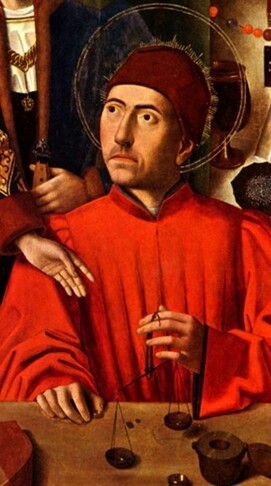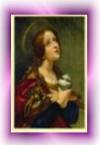His reputation spread rapidly, to the extent that ambassadors sought out St. Eligius. He had success in inducing the Breton prince, to make a pact with Dagobert, to increase his influence. King Dagobert loved him so much that he would often take himself out of the crowds of princes, dukes or bishops around him and sought private counsel form St. Eligius. St. Eligius took advantage of this royal favor to obtain alms for the poor, and to ransom captives Romans, Gauls, Bretons, Moors, and Saxons who were arriving daily at the slave market in Marseilles.
His friends recalled his appearance with love. He was tall, curly locks, and an appearance of honesty about him. He wore many jewels and his belt was made of gold. All the while, while giving the appearance of wearing fine silk and jewels, he wore a “hairshirt” next to his flesh, underneath all the gold and jewels. Eventually as his faith increased, he was seen giving all this gold and jewels to the poor, and wore burlap robes with a rope for a belt. He was known for self-mortification, and an overwhelming compassion for the poor. He entered the Religious life and went on to become Bishop.
He founded several monasteries, and with the King’s consent, sent his servants through towns and villages to take down the bodies of criminals who had been executed and gave them a decent burial. He and his friend Dado, lived according to the strict Irish monastic rule of St. Columbanus. He founded the monastery of Solignac, near Limoges, and founded a convent in Paris where he introduced this rule of monastic life to live by. He built the basilica of St. Paul and restored the basilica at Paris. He erected several fine tombs in honor of the relics of St. Martin of Tours and St. Denis.
He became a Bishop, and most in his new diocese were pagans. He undertook the conversion of Flemings, Frisians, Suevi, and the Barbarian tribes along the North Sea coast. He made frequent missionary excursions and also founded a great many monasteries and churches. He died on December 1st and was buried at Noyon. Several of his writings survive; a sermon in which he combats the pagan practices of his time, a homily of the “last judgment”, and letter written in 645, where he begs for the prayers of Bishop Desiderius of Cahors.

